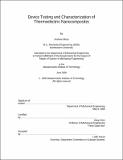| dc.contributor.advisor | Gang Chen. | en_US |
| dc.contributor.author | Muto, Andrew (Andrew Jerome) | en_US |
| dc.contributor.other | Massachusetts Institute of Technology. Dept. of Mechanical Engineering. | en_US |
| dc.date.accessioned | 2009-03-20T19:31:44Z | |
| dc.date.available | 2009-03-20T19:31:44Z | |
| dc.date.copyright | 2008 | en_US |
| dc.date.issued | 2008 | en_US |
| dc.identifier.uri | http://hdl.handle.net/1721.1/44915 | |
| dc.description | Thesis (S.M.)--Massachusetts Institute of Technology, Dept. of Mechanical Engineering, 2008. | en_US |
| dc.description | This electronic version was submitted by the student author. The certified thesis is available in the Institute Archives and Special Collections. | en_US |
| dc.description | Includes bibliographical references (p. 67-68). | en_US |
| dc.description.abstract | It has become evident in recent years that developing clean, sustainable energy technologies will be one of the world's greatest challenges in the 21st century. Thermoelectric materials can potentially make a contribution by increasing energy efficiency of some systems. Thermoelectric materials may play a role in the large scale energy industry, specifically in the applications of refrigeration and waste heat recovery. In this work a novel thermoelectric material will be tested for conversion efficiency. A Bi₂Te₃ nanocomposite has been developed by the joint effort of Prof. Gang Chen's group at MIT and Prof. Zhifeng Ren's group at Boston College. The material exhibits enhanced thermoelectric properties from optimized nanoscale structures and can be easily manufactured in large quantities. In order to better characterize its performance a novel power conversion measurement system has been developed that can measure the conversion efficiency directly. The measurement system design will be described in detail; important design considerations will be addressed such as measuring heat flux, optimizing the load matching condition and reducing electrical contact resistance. Finally the measured efficiency will be compared to the calculated efficiency from a temperature-dependent properties model. It will be shown that a Ni layer must be attached to the nanocomposite to allow soldering and power conversion testing. Results of this work will show that the nanocomposite efficiency is higher than the commercial standard. Electrical contact remains a challenge in realizing the potential efficiency. | en_US |
| dc.description.statementofresponsibility | by Andrew Muto. | en_US |
| dc.format.extent | 68 p. | en_US |
| dc.language.iso | eng | en_US |
| dc.publisher | Massachusetts Institute of Technology | en_US |
| dc.rights | M.I.T. theses are protected by
copyright. They may be viewed from this source for any purpose, but
reproduction or distribution in any format is prohibited without written
permission. See provided URL for inquiries about permission. | en_US |
| dc.rights.uri | http://dspace.mit.edu/handle/1721.1/7582 | en_US |
| dc.subject | Mechanical Engineering. | en_US |
| dc.title | Device testing and characterization of thermoelectric nanocomposites | en_US |
| dc.type | Thesis | en_US |
| dc.description.degree | S.M. | en_US |
| dc.contributor.department | Massachusetts Institute of Technology. Department of Mechanical Engineering | |
| dc.identifier.oclc | 301711036 | en_US |
